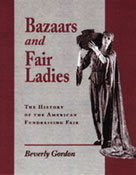Bazaars and Fair Ladies
The History of the American Fundraising Fair

- Author(s): Gordon, Beverly
- Series:
- Imprint: Univ Tennessee Press
- Publication Date: 1998-10-02
- Status: Active
- Available in Hardcover - Cloth: Price $45.00 | Buy Now
Although women’s charitable bazaars have contributed millions of dollars to important causes and institutions, they have long been thought of—by both historians and the public—as trivial events. Beverly Gordon corrects this view in Bazaars and Fair Ladies, the first history of women’s fundraising fairs in the United States. Tracing their development from the early 1800s to the present day, Gordon show how women’s fairs have reflected and influenced American culture, including styles of display and presentation, forms of public entertainment, attitudes about consumption and commodities, and perceptions of other cultures and of the past.
Gordon surveys the fundraising fair phenomenon through its various names and incarnations, including ladies’ sales, ladies’ fairs, fancy fairs, fetes, festivals, carnivals, boutiques, and church or charity bazaars, and the many causes these events have benefitted, such as abolition, suffrage, and war relief. Drawing on a wide variety of historical documents—newspaper and magazine accounts, souvenir programs, photos, scrapbooks—as well as on fictional representations, interviews with fairgivers, and participant observation, Gordon provides detailed descriptions of fairs characteristic of specific periods, recreating what it felt like to walk into a Civil War sanitary fair or into Boston’s “Atlantic City Boardwalk” fair of 1922. Throughout, she analyzes the ways in which the fundraising fair functioned as a vehicle for aesthetic and social meaning, creating rich environments that celebrated communal bonds.
Gordon stresses the role women’s bazaars played within the larger fair culture, demonstrating that many of the trends evident in American agricultural and trade fairs and international exhibitions had their origins in women’s fundraisers. Highlighting changes in fair themes, aesthetic environments, consumer fashions, and critical responses from the public, Gordon also looks at similarities and differences among participants from varied ethnic and geographic communities. Gracefully written and abundantly illustrated, Gordon’s study of this vital American cultural institution sheds light on 175 years of women’s creativity, fellowship, and community-building.
The Author: Beverly Gordon is a professor in the Environment, Textiles, and Design Department and serves the folklore and women’s studies programs at the University of Wisconsin–Madison. She is the author of several books, including Shaker Textile Arts and American Indian Art: The Collecting Experience.
